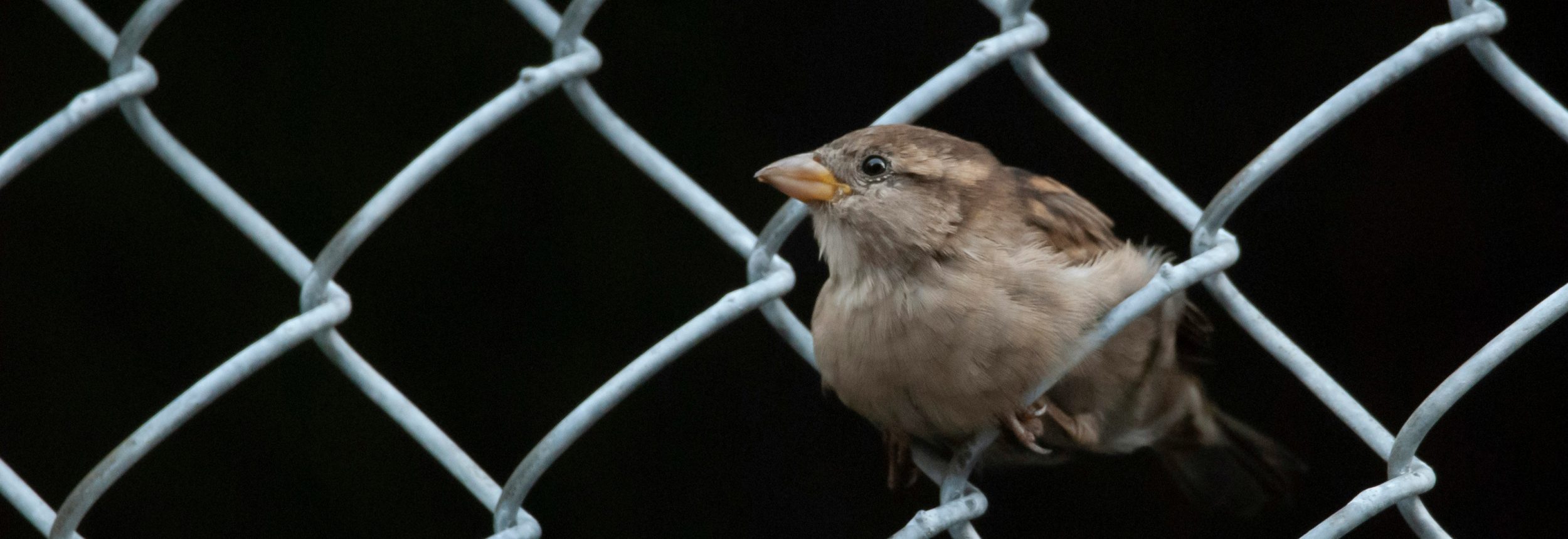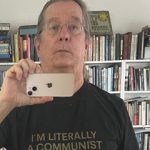
Building a front of people with enough power to block carceral expansion projects requires scanning a social landscape for issues that people are already mobilizing on, and thinking creatively about how to persuade organized people that a credible plan to win what they seek does not go through incarceration. We offer some examples from our organizing experiences where people in motion—in unions, workers centers, community radio stations, neighborhood associations, regional water districts—came to see their priorities as threatened by carceral spending choking off other life-enhancing investments and paths to freedom. In most of these settings, self-identified abolitionists are few and far between, and so we discuss the ways of operating—balancing the unproductive impulse to be perfectionist scolds with the political clarity to both transform pro-punishment consciousness and avoid resolutions that consolidate our opponents’ strength for the next round.
Ruth Wilson Gilmore: Frequently, people involved in various social movements think that being against prisons and jails has nothing to do with environmental justice, or labor struggles, or housing, or health care, or sexuality, or transportation, or pensions, or immigrants’ rights. Occasionally, though, the connections become really apparent. I thought maybe if we told a few stories about how the invisible becomes visible, we could inspire readers to notice other possibilities. There are so many different examples.
I’ll talk a little bit about Local 1000. SEIU Local 1000 is a vast union—96,000 people—of many different kinds of California state employees. Notably, they do not represent guards or parole officers, though they represent people who work in prisons in other jobs. Local 1000 had, for many years, gone through many internal struggles in which insurgent slates were trying to refresh democratic participation in a union that had become bureaucratized—a pretty common union story.
In the long campaign to stop the Delano II prison, we had talked to many different kinds of people, and inevitably our audiences included members of that union—in particular people who worked in the prisons as teachers. What caught their attention was our analysis of the state’s changing budget priorities, and they noticed how those changes were making it harder and harder to do their jobs. We were not arguing to support prison education, but rather showing in as many ways as we could how the social welfare capacities of the state were shrinking everywhere.
Eventually the insurgents within the union, most of whom did not work in the prison system, invited us, the abolitionists, to a meeting at their Sacramento office. We went thinking that we were going to be used as a threat to advance some reform they were trying to accomplish—that they would say, “Well, we’ll talk to these abolitionists if you don’t give us this little thing we want.” We’d been through experiences of that sort many times before. But we went because you can’t win without risking loss. To our surprise, the union’s legislative director began the meeting by declaring, “If you feel uneasy going up against the CCPOA (the prison guards’ union), you should leave now, because it’s on.” Union members carried the entire discussion about how prison expansion was starving the rest of the state’s social welfare spending. In this example of organizing with already organized people, we brought certain considerations to their attention without having any guarantee that it would result in cooperation with such radiating possibilities.
That story is one of many that arose in the context of overlapping and interlocking crises. I could tell a story about elementary and secondary school teachers in California, with whom some abolitionists built a statewide organization. They crafted curricula, involved kids in lobbying on their own behalf, and developed a workshop to train teachers union members in any state who might be outraged by the pipeline draining public money and young people from schools to prisons.
More from our decarceral brainstorm
Inquest, finalist for the 2025 National Magazine Award for General Excellence, brings you insights from the people working to create a world without mass incarceration.
Sign up for our newsletter to get the latest in your inbox every Saturday.
Newsletter
Craig Gilmore: I’m not going to tell a story so much as make an observation, which is that one of the things a new organizer is trying to sort out is what the political landscape is where they’re doing their organizing. And if they haven’t organized against the police budget or a new jail or a new prison or an ICE detention center before, there’s a lot to learn.
Some of the questions that can guide them in trying to figure out where to put their limited resources in terms of reaching out to the already organized are: Who is this project going to fuck with? Who’s going to be hurt if this project happens? And who’s already organized in a way that I might be able to go to them and pitch the idea that if the jail expansion happens or if the detention center is built, issues they care and campaign about and people they’re working with are going to be hurt.
In the case of SEIU in California, we approached them with a message of “they’re shrinking public goods in order to build more prisons,” which a couple of prison teachers had heard at one of our many public presentations. It wasn’t so much that we did outreach to SEIU: they found us. Militants within the union found us. But I think people who haven’t yet been approached by organized forces need to be able to think about, “Who should I be approaching? Who can I call and what kind of pitch can I make to convince them to join in this fight?”
Lydia Pelot-Hobbs: Part of the work is remembering that alliances that we take for granted now were not a given before they were made. For instance, after Hurricane Katrina the Congreso de Jornaleros (a grassroots organization focused on the rights of day laborers) became central to the campaign to shrink the New Orleans jail. Now we might say: “Of course, ICE detention facilities, jails, these are all cages for locking people up. This is an obvious coalition.” But that wasn’t always common sense. There had been immigrant detainees locked up in the New Orleans jail since at least the early 1990s. Organizations such as Amnesty International and Human Rights Watch did numerous reports about the atrocious conditions and the problem of immigrant detention in the New Orleans jail. But grassroots immigrant-justice organizing really didn’t take off in New Orleans until after Katrina, mostly because of the arrival of Central American workers, itself a product of the Bush administration’s rebuilding policies and programs.
During that period, the Congreso de Jornaleros was founded as part of the New Orleans Workers’ Center for Racial Justice and really took off, with hundreds of people showing up at their weekly membership meetings by 2010 or so. The members, who were originally mostly men, started having their wives and their loved ones come, while at the same time they were having children and intending to make New Orleans home long term for their families. While much of the early organizing had been around cases of wage theft, there was then an intensification of policing of the day laborer corners of New Orleans, amplified by ongoing contracts between ICE and the New Orleans jail. To paraphrase something former Congreso de Jornaleros organizer Jacinta González said to me: “Everything was shut down to the immigrant community of New Orleans except for the jail. The jail was the one place that had open arms for folks.” There emerged a political recognition that the jail was central to the machine of detention and deportations.
In this post-Katrina era, there was a lot of coalition building across the city. One effort was a movement infrastructure called the New Orleans Organizers Roundtable, which met monthly for grassroots organizations to share work they were doing and how others might lend a hand. Out of this space, Congreso de Jornaleros (among others) forged relationships with folks organizing against policing and incarceration. Congreso de Jornaleros ended up joining the Orleans Parish Prison Reform Coalition because they saw their shared interests. Which is to say, the escalation of the carceral state is also leading folks to find each other in struggle. The post-Katrina elite structure was trying to pit folks against each other, but instead it ended up being a moment of deepening political education and solidarity.
It got to the point where, at city council meetings, Congreso de Jornaleros members would make comments about what was happening to people who were unable to make bail, and then folks from various organizations against mass imprisonment and police violence would use their time at the mic to talk about the harms of ICE holds. This back and forth deepened and widened people’s politics, for instance, getting people who were interested in immigration but maybe not interested in criminalization—and vice versa—aligned in working against a bigger jail.
It was not just common sense. Consciousness was organized through these broader connections that folks were making through various activist infrastructures. The New Orleans Organizers Roundtable did not get built because there was going to be a jail campaign, but it was able to be utilized to help connect people around a jail campaign.
Judah Schept: I’m going to come at this topic from a slightly different angle and ask: What do you do when there isn’t an existing, identifiable political formation somewhere? The fight against the proposed federal prison in Letcher County, Kentucky, is an interesting example of this in practice. There is a long history of movement work in Letcher County—against strip mining, around anti-poverty and welfare rights organizing, for black lung benefits, etc. But at the beginning of the USP Letcher fight, it wasn’t those existing organizations but rather a bunch of young folks who organized themselves into a formation. Many of them were DJs at independent radio station WMMT—most especially the DJs of WMMT’s Calls from Home radio show, which airs song requests from people incarcerated in the eight prisons that fall within the station’s range. The show also records and broadcasts messages of love and support from people on the outside to their loved ones imprisoned in the region. WMMT is broadcast by the stalwart media arts organization Appalshop, which is located in the county seat of Whitesburg. (Amelia Kirby, whom I mentioned in an earlier installment, worked to create Calls from Home in the early 2000s. The film Calls from Home, directed by former WMMT DJ Sylvia Ryerson, documents the work of the show and its importance to folks inside.)
DJs for the show were politicized by the work of mediating between loved ones on the outside and people who were locked up, but also by the first iteration of the Black Lives Matter movement. They had placed a Black Lives Matter sign in the window at WMMT and started getting harassed by the Whitesburg police. Through the radio show, BLM, and their own subjection to police harassment, these young people had arrived at a political analysis that could identify USP Letcher as an expression of the same forces that had killed Trayvon Martin, Mike Brown, and Freddie Gray. They began organizing as the Letcher Governance Project and, in conversation with other southern movement folks, devised the #our444Million hashtag (asking what other needs could be met by the $444 million allocated to building the prison), which would become an invaluable framing device in the campaign and beyond.
In fact, their work became instrumental to the eventual defeat of the first USP Letcher prison proposal. Today, many years later, as we again fight attempts to build a federal prison in Letcher County, the players have shifted, in no small part because of what happened the first go around. Now there is a group on the ground in Letcher County called Concerned Letcher Countians (CLC), which is a major force within the Building Community Not Prisons (BCNP) coalition. CLC is comprised of about two dozen people, many of whom are older and who have some connection to the longer legacy I described of political work connected to the coal fields—anti–strip mining, environmental activism, anti-poverty work—for whom it may have taken the first round of fights to begin to see how the prison connected to the issues they’d fought for. When the prison was reproposed following the 2022 floods, I think that was the moment for a lot of them that they were like, “Oh, this is actually the same fight.” And now they’re this incredible force who are really the heart and soul of the coalition. [Editor’s Note: The Institute to End Mass Incarceration, which publishes Inquest, assists both CLC and BNCP with their organizing.]
Ruth Wilson Gilmore: Those are fantastic examples from New Orleans and from Letcher County. And they make me think back to California and how these insurgents within Local 1000 came to hear about the struggle against the Delano II prison. California is giant, but they heard about it because we, among other things, rolled all over the state, holding hearings for what we called the “Shadow Commission,” which was something we had invented in order to draw audiences into conversations. We would announce hearings and advertise them and sit up in front of the room, nicely dressed, and invite people to come talk to us about what they were already trying to do in their communities: what a prison or more police might or might not interrupt or enable in their communities. And that’s how we could learn about already organized people, and already organized people as well as individuals (who might become organized) could share with each other how something presented officially as a benefit was, for many, an interruption, a displacement, or a threat. They heard each other, which was as important as encountering us. One time the Shadow Commission held a hearing at Fresno City College, and an older guy came tearing in really late, full of anxiety, saying, “Am I too late? Do I have a chance to testify?” And we said, “Yes, please testify!” He had just come from visiting his son at one of the prisons. And he was completely amazed that anybody was holding any kind of hearing whatsoever in Fresno to talk about these things. So while he spoke as an individual, not as a member of an organization, his testimony inspired people in the room who had been strictly listening to take the mic and talk about their own experiences and organizations. The conversation shifted to a new and different level of intensity. The Shadow Commission left at the end of our hearing, but the intensity and networks remained and grew.
Judah Schept: I think part of what we’re getting at is that there’s an innate tension: On the one hand, we have our own principled commitment to abolition. On the other hand, when we’re either attempting to activate other people politically or are working in a coalition, we can’t necessarily always control—and perhaps shouldn’t try to—the way the messaging about the prison or the jail or the ICE detention center is expressed in every geographic or political context. That tension doesn’t get resolved the same way every time. There are times when it is important to offer an abolitionist reframing of a question posed in a meeting, and there are times to strategically let go of a corrective impulse and recognize that other frameworks or idioms may in fact make more sense in a particular context, if the effect down the road is to strengthen our position.
Lydia Pelot-Hobbs: This brings to mind another story related to the Orleans Parish Prison Reform Coalition. At one point in the campaign, organizers identified the need to organize the Mid-City Neighborhood Organization where the jail is located. They were like, “We know their orientation is going to be against a jail expansion through NIMBY (Not in My Backyard) politics—as if the main harms of the jail were the risks posed to homeowners and their property values by incarcerated people and their loved ones coming to the neighborhood—but can we shift that so people are also against the violence of criminalization and jailing?” Not by coming in and demanding that everyone “be abolitionists.” But to go and do teach-ins about the various ways the jail wasn’t in their or their neighbors’ interest, to steer the neighborhood association away from only thinking about property values, to highlighting the layered violence of jailing. I was not in these teach-ins, but I’m sure there were people there who talked about “criminals” and “danger” and so on. But the organizers didn’t leave the room. They didn’t shut down the conversation. They shifted the conversation by engaging in political education that not only met people where they were at but deepened collective analysis by raising questions about city priorities marked by uneven investments in carceral versus social institutions. And the Mid-City Neighborhood Organization came out against building a bigger jail, which had a real impact on their council member’s vote. These homeowners were not people who would typically be seen as likely allies, but organizing them made them part of the struggle.
Ruth Wilson Gilmore: Just because you don’t expect it doesn’t mean it’s impossible. When we organized the lawsuit to stop the Delano II prison, we got a sign-on from the regional water district. The guy who was the district’s chief staffer was not for us—but he was against the threat to the water table, and was willing to put into writing everything that was wrong with building a prison (which is a city) onto the diminishing water table of an already existing city. That was an unexpected but also completely sensible connection.
Craig Gilmore: And he had the ears of all the big growers. They depended on him to manage the water in the entire district. So he had first-name relationships with all the most powerful people in the county. Once he came over, and the editor of the local newspaper came over, suddenly the local support for the prison started draining away. The local elite who had pushed for the prison saw it wasn’t going to help the local economy and was going to drain the local water table. In each of these cases, the actual process of organizing helped groups of people trying to do certain things realize that prisons were an obstacle, rather than part of a solution, to the things they were trying to accomplish. This, in turn, amplified everybody’s energy. Looking around, listening, and thinking creatively about how to engage with their understanding of the issues that put them in motion—this is what we mean by mobilizing the already mobilized.
Image: Tyler Jamieson Moulton / Unsplash




